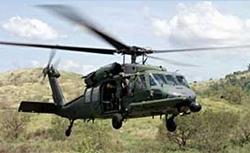Sat, Jul 05, 2003
Six Crewmembers Killed In Afghanistan
 The dark of night. A complex
refueling operation at high altitude. A pilot who may have suffered
a heart attack. All of these factors may have contributed to the
May 23 crash of a Sikorsky HH-60G "Pave Hawk" Special Operations
Helicopter in Afghanistan, according to a military report issued
Thursday.
The dark of night. A complex
refueling operation at high altitude. A pilot who may have suffered
a heart attack. All of these factors may have contributed to the
May 23 crash of a Sikorsky HH-60G "Pave Hawk" Special Operations
Helicopter in Afghanistan, according to a military report issued
Thursday.
In the Dark Of Night
The investigation, led by Brig. Gen. Gregory Power (USAF), found
that the accident occurred at 9,000 MSL in a mountainous area near
the Afghan town of Ghazni. The crew was airlifting two Afghan
children for medical care. It was just past dusk, according to the
report, when the Pave Hawk maneuvered for aerial refueling behind a
HC-130P tanker at a mere 350 ft. AGL. That's well below the 500
foot minimum required by the military.
While listing as the three primary causes the
rapid fall of night and the high altitude, the report also detailed
the autopsy performed on aircraft commander Lt. Col. John Stein.
Forensic experts concluded Stein suffered from 95 percent blockage
of his coronary artery.
"This raises the possibility that the aircraft commander may
have been undergoing angina (news - web sites) (chest pain) cardiac
arrhythmia (abnormal heart rhythm) or acute myocardial infarction
(heart attack) during the helicopter refueling or later in the
mishap sequence," the report said, as quoted by Reuters. However,
one Air Force medical witness told the investigating team that
Stein had no complaints about chest pains and had passed a physical
which included riding a stationary bicycle. The only way to find
out for sure during the flight medical would have been to
operate.
No Cause Determined
 The Air Force refused to issue a
primary determination in the accident. However, the investigation
report indicated that the Pave Hawk was trying to refuel as day
turned into night, rendering the flight crew's night vision goggles
less-than-effective.
The Air Force refused to issue a
primary determination in the accident. However, the investigation
report indicated that the Pave Hawk was trying to refuel as day
turned into night, rendering the flight crew's night vision goggles
less-than-effective.
"The terrain's high altitude ... combined with the 30-degree
bank during the refueling aircraft's climbing turn, made it
difficult to maintain the helicopter in the refueling position,"
the Air Force said in a statement. Local commanders will decide
what, if any, disciplinary action will be taken in the
incident.
More News
From 2023 (YouTube Edition): New Propulsion Scheme Optimized for AAM Applications Founded in 2017 by Eric Bartsch, Pat Anderson, and Erik Lindbergh (grandson of famed aviation pion>[...]
During The Initial Climb, The Engine Began To Operate Abnormally And, After About Three Seconds, Experienced A Total Loss Of Power On October 29, 2025, about 1820 Pacific daylight >[...]
Aero Linx: Women in Aviation International Women in Aviation International is the largest nonprofit organization that envisions a world where the sky is open to all, and where avia>[...]
“We’ve paid for the cable line’s repair for the customer and have apologized for the inconvenience this caused them...” Source: Some followup info from an A>[...]
“We have long warned about the devastating effects of pairing optimization. Multiple times over many months, we highlighted how schedule manipulation, unbalanced schedules, a>[...]
 Classic Aero-TV: VerdeGo Debuts VH-3 Hybrid-Electric Powerplant
Classic Aero-TV: VerdeGo Debuts VH-3 Hybrid-Electric Powerplant NTSB Prelim: Grumman American Avn. Corp. AA-5B
NTSB Prelim: Grumman American Avn. Corp. AA-5B ANN's Daily Aero-Linx (12.02.25)
ANN's Daily Aero-Linx (12.02.25) Aero-News: Quote of the Day (12.02.25)
Aero-News: Quote of the Day (12.02.25) Aero-News: Quote of the Day (12.03.25)
Aero-News: Quote of the Day (12.03.25)




